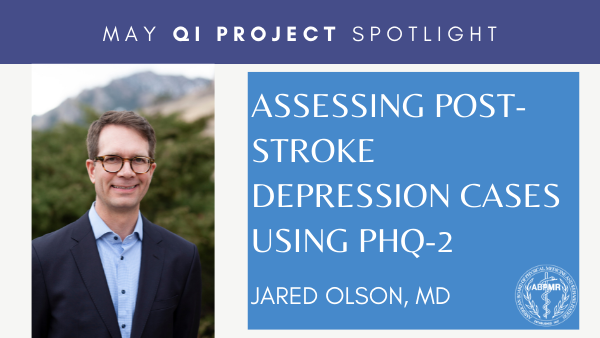CC
QI Spotlight: Assessing Post-Stroke Depression Cases Using PHQ-2

The May QI Project Spotlight was submitted by Jared Olson, MD.
Dr. Olson observed cases of depression are common after a stroke; he also sees a high number of post-stroke patients in his practice. Before completing his QI project, there was no consistent evaluation of post-stroke depression, leading to a high risk of missing cases of depression.
The QI project focused on implementing a depression assessment tool for his patients using PHQ (Patient Health Questionnaire)-2, a questionnaire used to screen for depression in patients. Dr. Olson was able to use PHQ-2 assessments in every patient encounter to ensure no cases of depression were overlooked.
Thank you for submitting your QI project, Dr. Olson!
The QI Project Spotlight (formerly the PIP Spotlight) is a periodic feature on the ABPMR News Center to highlight exemplary Quality Improvement projects submitted by your fellow diplomates (or residents) for continuing certification (CC) credit. Diplomates can use the QI Project Spotlight as a tool to plan their own QI projects or as a way to connect with other diplomates doing similar work.

What is the problem you are trying to solve?
Depression is common after a stroke as observed clinically in my practice and as discussed in Winstein Carolee J. et al., 2016. (Guidelines for Adult Stroke Rehabilitation and Recovery. Stroke; a journal of cerebral circulation, 47(6), pp.e98–e169), and is clinically relevant in rehabilitation patients. Unfortunately, I am at high risk of missing cases and potential interventions because I am inconsistent in my formal evaluation of post-stroke depression. Loosely, my current practice of mood assessment in the acute consult setting is really only triggered if I sense a depressed affect, but I acknowledge that affect alone is not necessarily a good indicator.
What data (objective measurements) do you have that supports this as a problem?
I reviewed records and while I may comment on mood and affect in the physical exam, it is rarely supported by any validated depression assessment tool. If I sense that depression may be an issue, then I may use a PHQ [Patient Health Questionnaire]-9 which is rather sensitive; I usually do not use that tool in routine encounters due to time constraints. These are consultations in the inpatient acute care environment.
What is your opportunity statement? State the goal you hope to achieve.
I believed that I was doing formal assessments with the PHQ-9 when depression was clinically suspected, but in reality over the period in question, I did not do it at all. The opportunity to incorporate a validated depression screening measure is great, and the goal is 100% assessment in patients who are able to reliably participate in questioning.
What is the underlying cause of the performance/quality problem?
I have previously tried to incorporate the PHQ-9 into my workflow with limited success in the inpatient setting. I have also considered using the PHQ-2, which is used successfully in an outpatient setting as part of hospital protocol at a different facility. However, I would often find that I would forget to use it. The problem appeared to be two-fold: incorporating an easy-to-use and fast clinically-validated metric for measuring depression in every new patient encounter, and also remembering as a practitioner to administer and record it.

What change(s) did you implement?
I first made sure that I had a PHQ-2 template for every patient, and I incorporated the PHQ-2 question into my EMR [Electronic Medical Record] template. I would find that when speaking to the patient, I would often not remember to ask them until I was back at my workstation doing documentation. It wasn’t until I resurrected a template during the course of this project for taking notes in the clinical encounter and modifying that to incorporate the PHQ-2 that I started doing it reliably. It also reminded me to ask other questions more routinely. Lastly, I found that having the PHQ-2 memorized made the questions sound more natural and less disruptive to the overall flow of the visit.

Did you achieve your goal or target from your opportunity statement? What data do you have to support your conclusion?
Yes. I was able to increase the reliability of administration of the PHQ-2 to assess for depression in all patient encounters (100%) once I implemented the additional step of including the assessment in my patient-encounter note sheet. It didn’t work to just include it in the EMR template as determined by an interim assessment, which, surprisingly to me, didn’t increase compliance at all (0%). I found that changing my clinical practice required a point-of-care reminder, and as mentioned earlier, memorization of the PHQ-2 questionnaire.

Will you continue with the changes you have implemented?
Yes, I will continue with the PHQ-2 assessments in every clinical encounter. Though not an outcome that I measured, anecdotally I was surprised on a few occasions to uncover substantial depression (especially pre-morbid) in patients that I would not have otherwise found. I suspect that even my previous informal evaluations of mood did not detect many cases of depression. Although I plan to continue using the clinical encounter template for handwritten notes for now, I believe that the final solution may be in the form of an EMR template that I use in patient rooms. For now, access to computers in the patient room is somewhat of a barrier so handwritten notes are most efficient, even though I need to transcribe to the EMR after the encounter. I will also be reviewing best practice guidelines to incorporate other “quick checks”.

